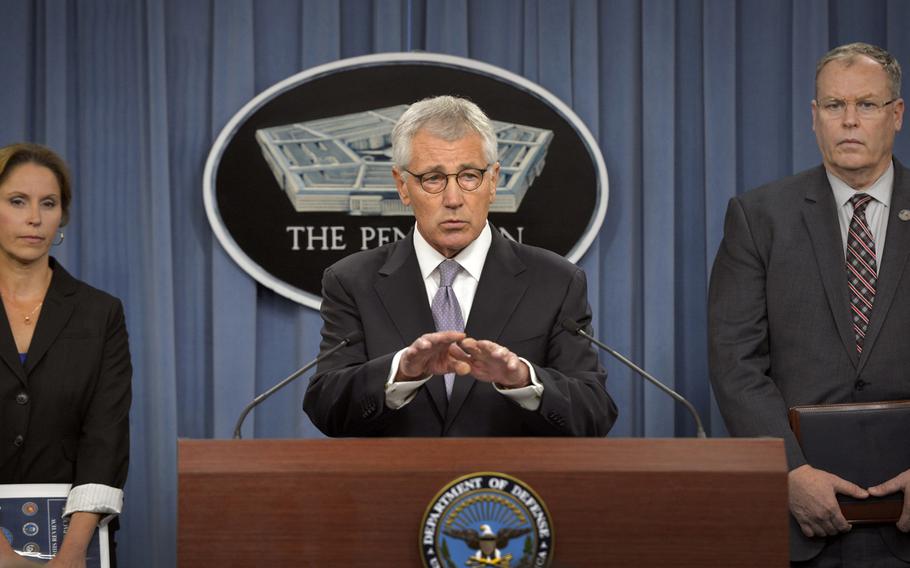
Secretary of Defense Chuck Hagel and Deputy Secretary of Defense Bob Work, right, brief the press on the Military Health System, October 1, 2014. (Glenn Fawcett/Department of Defense)
WASHINGTON — The Department of Defense’s in-house review of its medical system concluded the department generally provides “safe and timely” care on par with non-military health care, according to a report released Wednesday. But the review also found significant examples of substandard care at individual facilities, including inadequate investigation of cases with bad medical outcomes.
“We cannot accept average when it comes to caring for our men and women in uniform and their families,” Secretary of Defense Chuck Hagel said at the Pentagon.
The review, overseen by Deputy Secretary of Defense Bob Work, looked at performance measures in three areas – health care quality, patient safety and access to care – at more than 50 military hospitals and 600 clinics serving 9.6 million patients worldwide, including active duty, family members and retired servicemembers. The report also reviewed health care purchased from the private sector.
The military’s health care system is unmatched in its performance on the battlefield and in operational environments, Hagel said. In other areas, he said, it needs work,
He announced several immediate steps to improve care:
Military facilities providing substandard care must provide action plans for improvement within 45 days. DOD will establish unified standards of care for military treatment facilities and care from the private sector. DOD will establish a feedback system for patients and others to report experiences. The Pentagon will establish a system-wide performance management system to examine problems. All available performance data will be made public. “By the end of the year DOD will have a detailed implementation plan to ensure that the military healthcare system becomes the top performing system we all expect it to be and want it to be,” Hagel said. “These steps are the beginning.”
The results in the three performance categories were mixed, the review concluded, with significant performance differences found from one facility to the next. Moreover, the report said data is frequently not collected properly, with required “root cause analysis” reports on bad medical outcomes are sometimes not submitted by the services.
“Although there are areas in which the MHS excels, there is considerable variation across the system, both for specific clinical measures and for individual [military treatment facilities],” according to the report.
Among the findings, the military heath system performed above the national average in eight of 18 selected performance measures commonly used by healthcare systems, while seven fell between the 25th and 50th percentile, and three measured below the 25th percentile.
Hagel ordered the sweeping review of the military health system in May amid worries sparked by problems with access and care in the Veterans Health Administration. The problems there grew into a scandal that resulted in the firing of the Department of Veterans Affairs’ top executive and an overhaul of the department.
“He wants to know what we don’t know,” Pentagon press secretary Rear Adm. John Kirby said at the time of Hagel’s order. “He doesn’t want to wait for similar allegations to appear with the active military health care system.”
The review order coincided with the announcement that the head of Womack Army Medical Center at Fort Bragg, North Carolina, had been relieved of his duty in the wake of two deaths at the hospital and problems with surgical infections, the New York Times reported.
An investigation by the paper, published in June, uncovered documents suggesting that the overall level of care in military hospitals is inferior to the civilian system.
Among the chronic problems the paper reported were failure to reliably report problems and higher than expected rates of harm and complications in two central areas — maternity care and surgery.
Babies born at military hospitals are twice as likely to be injured during delivery as those born as those born nationwide, while their mothers disproportionately experience hemorrhage after childbirth, the Times reported.
According to the report released Wednesday, data from the National Perinatal Information Center shows lower rates of infant mortality and maternal trauma than the national average. But with other problems relating to childbirth, including hemorrhage and “undefined neonatal trauma,” the military system performs worse than civilian hospitals.
Military treatment facilities lag behind civilian hospitals in other safety measures too, including bloodstream infections from central venous catheters. Surgical mortality rates, however, were “within expected rates” compared to other health systems, the report said.
Although the report found that the military system overall was providing patients satisfactory access to care without excessive waits, patients in many case were unsatisfied — a finding that requires more study to see whether the data is correct, Work said.
“Access is one of the issues that we have heard back that our data is not actually reflecting what our beneficiaries perceive,” he said.
carroll.chris@stripes.com Twitter: @ChrisCarroll_